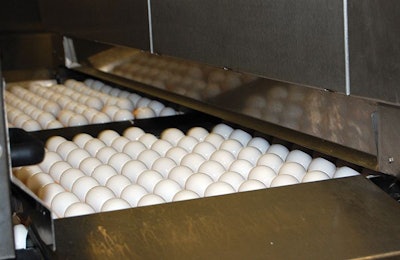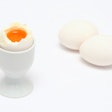
Bacterial contamination of table eggs continues to be a food safety risk for egg producers.
To reduce this risk, shell eggs for human consumption in the U.S. are washed and sanitized prior to being packed. In addition, a small percentage of shell eggs in the U.S. are pasteurized in hot water baths prior to packing. Two new techniques that can be applied to shell eggs to reduce food safety risks, one utilizing microwaves and the other employing hydrogen peroxide and ultraviolet light, were presented November 21, 2019, at the Poultry Tech Summit.
Microwave pasteurization of shell eggs
Satyanarayan Dev, Ph.D., vice president for research, Microsystems First Inc., explained the steps he went through to develop a microwave system for pasteurizing shell eggs that can be implemented inline immediately after eggs have been washed, graded and sorted by size. The pasteurization system features a rectangular waveguide with holes at specific intervals. The holes in the waveguide allow for the microwave energy to be applied to the egg intermittently.
Dev said the entire process is completed in three minutes, with the first 30 seconds used to raise the temperature of the egg and then, over the last 2 minutes and 30 seconds, intermittent microwave energy is applied to maintain the elevated temperature in the egg. Pasteurization of the egg in the shell requires that 62 C (143.6 F) be reached in the yolk and 57.5 C (135.5 F) in the white, according to Dev.
Eggs were experimentally inoculated with Salmonella and then incubated to allow the Salmonella to replicate. These eggs were then treated with the microwave system and a 7.2 log reduction in the Salmonella numbers versus the control eggs was achieved.
In quality tests, the microwave-heated egg whites were compared with the water bath-heated ones. The microwave-treated egg whites had a higher enthalpy of denaturation, higher viscosity, has less turbidity (were clearer), had a more stable foam with less foam density and had a relatively longer shelf life.
Dev estimated the operating cost for the microwave pasteurization equipment at $0.012 per dozen eggs. He said the microwave system is not sanitizing the eggshell itself, but that it was possible to use pulse electric field to kill any Salmonella on the shell of the eggs.
Sanitizing eggshells
Craig Coufal, Ph.D., founder and president, Innovative Poultry Solutions LLC, discussed how hydrogen peroxide and ultraviolet light can be used in tandem to significantly reduce the microbial load on eggshells. In research published in Poultry Science, the hydrogen peroxide and ultraviolet light treatment was found to significantly reduce the aerobic plate count and Salmonella enteriditis on eggshells that were experimentally inoculated. The microbial counts for eggs treated with hydrogen peroxide and ultraviolet light were significantly lower than those of eggs treated with chlorine spray, quaternary ammonium compound spray, or peracetic acid spray (either alone or in combination with ultraviolet light).
Coufal also discussed published research which demonstrates the efficacy of the hydrogen peroxide and ultraviolet light treatment for sanitizing hatching eggs. Sanitizing the eggs can increase the rate of hatch and improve the quality of hatchlings. Hatching egg sanitation with hydrogen peroxide and ultraviolet light can improve hatchability and performance of broilers.
He said Innovative Poultry Solutions has 15 units in the field in the U.S. to treat chicken hatching eggs, either on the breeder farm or at the hatchery. The process can be done at the breeder farm before eggs are packed for transport to the hatchery or immediately before setting the eggs in the incubator. Because the reaction of the hydrogen peroxide and ultraviolet light happens quickly, the ultraviolet light is only applied for about four seconds. This means the equipment has a small footprint.
The reduced use of antibiotics in poultry production, particularly at the hatchery, has increased the importance of setting only “clean” hatching eggs in incubators. But eggs that are visibly clean can still carry bacteria and mold into the incubator, where they can negatively affect the rate of hatch and the survival of hatchlings on the farm. Turkey hatching eggs are commonly washed prior to incubation, but washing broiler hatching eggs is not common practice in the U.S. Fumigation with formaldehyde is no longer done in U.S. hatcheries.


















